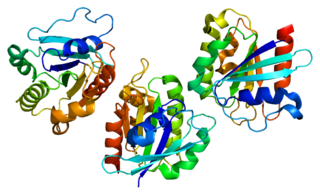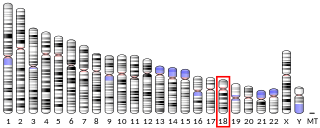
FMR1 is a human gene that codes for a protein called fragile X messenger ribonucleoprotein, or FMRP. This protein, most commonly found in the brain, is essential for normal cognitive development and female reproductive function. Mutations of this gene can lead to fragile X syndrome, intellectual disability, premature ovarian failure, autism, Parkinson's disease, developmental delays and other cognitive deficits. The FMR1 premutation is associated with a wide spectrum of clinical phenotypes that affect more than two million people worldwide.
A trinucleotide repeat expansion, also known as a triplet repeat expansion, is the DNA mutation responsible for causing any type of disorder categorized as a trinucleotide repeat disorder. These are labelled in dynamical genetics as dynamic mutations. Triplet expansion is caused by slippage during DNA replication, also known as "copy choice" DNA replication. Due to the repetitive nature of the DNA sequence in these regions, 'loop out' structures may form during DNA replication while maintaining complementary base pairing between the parent strand and daughter strand being synthesized. If the loop out structure is formed from the sequence on the daughter strand this will result in an increase in the number of repeats. However, if the loop out structure is formed on the parent strand, a decrease in the number of repeats occurs. It appears that expansion of these repeats is more common than reduction. Generally, the larger the expansion the more likely they are to cause disease or increase the severity of disease. Other proposed mechanisms for expansion and reduction involve the interaction of RNA and DNA molecules.

Integral membrane protein GPR155, also known as G protein-coupled receptor 155, is a protein that in humans is encoded by the GPR155 gene. Mutations in this gene may be associated with autism.

Fragile X mental retardation syndrome-related protein 1 is a protein that in humans is encoded by the FXR1 gene.

Cytoplasmic FMR1-interacting protein 2 is a protein that in humans is encoded by the CYFIP2 gene. Cytoplasmic FMR1 interacting protein is a 1253 amino acid long protein and is highly conserved sharing 99% sequence identity to the mouse protein. It is expressed mainly in brain tissues, white blood cells and the kidney.

Trinucleotide repeat-containing gene 6A protein is a protein that in humans is encoded by the TNRC6A gene.

Non-histone chromosomal protein HMG-17 is a protein that in humans is encoded by the HMGN2 gene.

Myosin-binding protein C, slow-type is a protein that in humans is encoded by the MYBPC1 gene.

TRIO and F-actin-binding protein is a protein that in humans is encoded by the TRIOBP gene.

E1A-binding protein p400 is a protein that in humans is encoded by the EP400 gene.

ADP-ribosylation factor-like protein 6 is a protein that in humans is encoded by the ARL6 gene.

Heterogeneous nuclear ribonucleoprotein A0 is a protein that in humans is encoded by the HNRNPA0 gene.

PAX-interacting protein 1 is a protein that in humans is encoded by the PAXIP1 gene.

Nuclear fragile X mental retardation-interacting protein 2 is a protein that in humans is encoded by the NUFIP2 gene.

Zinc finger protein 161 homolog is a protein that in humans is encoded by the ZBTB14 gene.

Trinucleotide repeat-containing gene 6B protein is a protein that in humans is encoded by the TNRC6B gene.

Guanine nucleotide-binding protein subunit beta-like protein 1 is a protein that in humans is encoded by the GNB1L gene.

WD repeat-containing protein 24 is a protein that in humans is encoded by the WDR24 gene.

ATP-binding cassette sub-family A member 9 is a protein that in humans is encoded by the ABCA9 gene.
David L. Nelson is an American human geneticist, currently an associate director at the Intellectual and Developmental Disabilities Research Center (1995), and professor at the Department of Molecular and Human Genetics at Baylor College of Medicine BCM since 1999. Since 2018, he is the director at the Cancer and Cell Biology Ph.D program, and the director of Integrative Molecular and Biomedical Sciences Ph.D since 2015 at BCM.
















